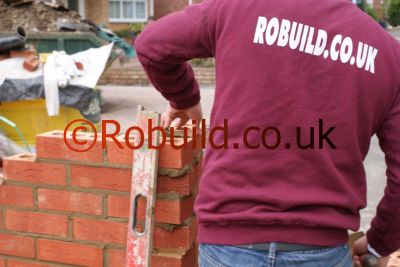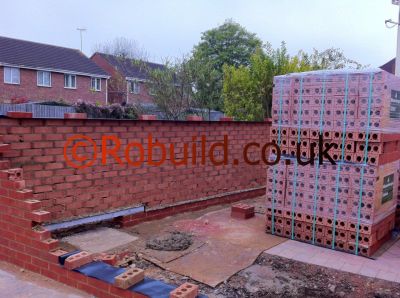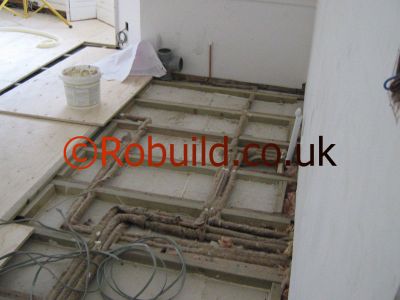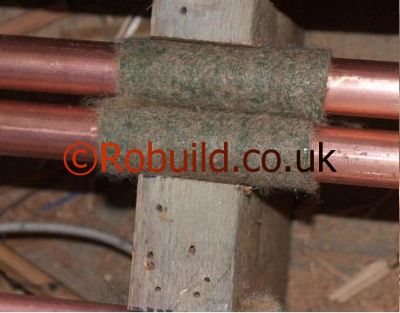Laundry room extensions
The advent of automatic washing machines and dryers has meant that domestic laundry activities no longer require constant attention, and can therefore be removed from the rest of the kitchen work. A separate laundry room is safer, quicker, quieter and cleaner than a washing machine operated at the kitchen sink, and makes the whole process more pleasant. The position of the laundry activities depends, to a great extent, on the existing plumbing in your home. There are also other practical considerations to bear in mind when designing a separate laundry room.
Traditionally, ‘washday’ has always monopolised the kitchen as well as most of a housewife’s time. A wet washday has tended to take over the whole house, with rivers of condensation and a general damp smell everywhere. Modern automatic appliances have gone a long way to alleviate this, and there are now single machines which wash, rinse, dry and air clothes at the press of a button. These are fairly rare, however, and obviously expensive. Although the average automatic washing machine is installed in the general kitchen area, several inconveniences remain.
Dirty clothes come close to food, and clean clothes are liable to acquire cooking odours if not dealt with immediately. The kitchen sink remains in constant use, and a general washday atmosphere prevails. Following the development of automatic laundry appliances, the next logical step is to isolate the whole laundry operation from the food area and place it in a separate room.
The size of a laundry A home laundry room does not have to be very large in order to be workable, and variations will depend on your individual requirements. An area 2.5m x 2.5m (8ft x 8ft) is sufficient to fit an automatic washer, separate tumble dryer, sink and adequate working surface for sorting, folding and ironing. For most people, space set aside for a single activity is a luxury, and it may be necessary to incorporate your laundry within a general utility room with washing as the main function.
In such cases the possible sizes will vary considerably. Since the finishes will be hard-wearing and practical, the room could also be used by children for drawing and painting, or by adults—for wine- and beer-making, for instance. If you are thinking of a secondary function for the laundry room, bear this in mind from the start so that adequate storage space can be included.
Positioning a laundry
You may be limited in your choice of position for a laundry. If none of your rooms is suitable for conversion, consider building on an extension. The position of a conversion or extension should be influenced strongly by the existing plumbing in your house. Laundries need hot and cold running water and a waste outlet. Position the laundry as close as possible to the existing water supply and drains, as this will enable a simple connection to be made to the water supply.
It be made to the water supply. It will also reduce, or eliminate, the need for the installation of new drains (underground), which can be very expensive. Ideally the waste pipe (above ground) from your laundry appliances should issue directly into the existing gully (sink at ground level leading to the drain). You may consider that other factors take priority over the cost of extending a drainage system. Access, for instance, is one which is very important and is influenced by the size of your wash and when you do it. A housewife with a large family, living in a house, will probably want easy access from the kitchen and to the garden. A young wife with no children, who is out at work all day, and lives in a flat, may find a room off an upper floor bathroom quite adequate for a laundry.
Possible conversions There are several possible conversions which may not be immediately apparent. A garage which is built into or onto a house would lend itself to being a laundry, providing there is sufficient space elsewhere to build a separate garage. A very large kitchen may become safer, more efficient and better looking if part of it is divided off to make a laundry. Older buildings often have a network of single-storey outbuildings, including redundant fuel stores and sculleries.
These are usually suitable for conversion into a laundry, or alternatively you could demolish them and build a new extension in their place. When planning an extension, remember to leave adequate external access from the front to the back of the house. This should be at least 915mm (3ft) wide to leave enough room for refuse collection. Avoid placing windows which open outwards onto such narrow accesses, as these can cause serious accidents. Laundry appliances Appliances vary considerably in size, and the price range for each type is wide. Your local dealer will be able to supply you with detailed information on the types available, and help you to find the right appliances to suit your heeds.
Washing machines
There are four main types of washing machine: 1. The single washing unit for rapidly washed small loads. Hand or powered wringers are available and often fit on top of the washing machine. This type doesn’t warrant being the centre piece of a laundry, but may well serve as a second machine in a communal room. 2. The twin tub, which incorporates a separate washing machine and spin dryer in a single cabinet. The clothes are handled between the washing and the drying operations, and controls have to be adjusted at certain stages. Twin tubs cannot be plumbed in, but are easily stored and moved. 3. Semi-automatic machines have an integral washing, rinsing and spin drying tub. The washing does not have to be handled between operations, but controls have to be adjusted at various intervals during the complete programme. Semi-automatic machines can be plumbed in or left mobile. 4. Fully automatic machines wash, rinse, and spin dry without the clothes being handled. Some more expensive types automatically tumble dry as well. Once a programme is set, the complete cycle works without any further attention. Automatic machines are usually plumbed in, but this is not essential.
Dryers
There are three main categories of dryer, or drying aid: 1. Spin dryers are available as separate machines, independent of automatic and twin tub machines. They do the job of a wringer—extract water from clothes. Spin dryers also rinse clothes, but there is no heat involved. 2. Tumble dryers are usually available as a unit separate from automatic washing machines. They take the place of the washing line, and some can be adjusted to air clothes as well. Tumble dryers are usually fitted with a vent which exhausts damp air to the outside. 3. Drying cabinets are available in many sizes, and some are small enough to fit under work benches. They consist of a heated and ventilated cabinet with hanging rails fixed inside, and the heat can be controlled to dry or just air clothes.
Ironers
Two main types of ironing machines are available: flat bed or rotary. They are useful for large quantities of simple ironing, but a hand iron is still necessary for complicated garments. When choosing which appliance to buy, you should consider the available space, the amount of washing you handle, available time, and the amount of money you can spend. Automatic machines require fresh hot water for every load, but with twin tubs careful selection of loads enables the same water to be used several times. Thus a second load can be washing while the first is spin drying, and large quantities of washing are dealt with more quickly and economically than with an automatic machine.
A well-equipped laundry should have a deep sink for some soaking prior to machine washing, and for hand washing. Provide hanging rails over the sink for drip-dry clothes, and also a draining board if the sink is not large enough to catch all the drips. A working surface approximately 1.83m x 610mm (6 ft x 2 ft) is necessary for sorting, folding and temporary stacking of clothes. The top should be strong enough to take an ironing machine if required, and should be 864mm (2ft lOin) high for ironing in a standing position. A retractable lower board can be incorporated for seated ironing. Storage should include a cupboard out of children’s reach for bleaches, dyes, detergents, washing powders etc. A tall cupboard is also required if you use a portable ironing board. This should be fitted with a fire proof lined, ventilated compartment for immediate storage of a hot iron. Provision of storage for dirty clothes, clean linen and an airing cupboard will depend on the layout of the rest of your home. If you are generally short of such space, large cupboards in the laundry could be very useful.
Electrical requirements
When planning electrical outlets, you should consider lighting, appliances, heating and ventilation. Provide a socket outlet for each appliance, not forgetting the iron, and extra outlets for future modifications. Provide ceiling lighting points so that you are never working in your own shadow. Pullcord switches are preferable where hands are likely to be wet. Under-floor heating is ideal for a laundry, in which case wiring has to be installed when the floor is being constructed. An electrical extractor fan placed high in an external wall is an asset.
Water Supply
Place the washing machine and the sink as close to the existing water supply as possible. The water can be supplied hot or cold, depending on the appliance and the general water system in your home. If the water arrives hot you save time, especially with an automatic machine which empties after every cycle. On the other hand, extracting water from your household system will rob your central heating or bathroom of hot water. Appliance manufacturers usually state whether hot or cold water should be used. To obtain water from your main supply, form a junction at a convenient height in the existing pipe. Insert a stop-tap in the extension pipe so that the machine can be moved without having to cut off the water supply to the whole house.
Appliances are fitted with a flexible hose for easy connecting and tolerance when finally positioning the machine. You should try to conceal pipes from general view wherever possible. Machines should be filled at the water pressure recommended by the manufacturers. Consult your water board for local pressures, and they will advise you on the kind of regulating valve you will need, if any, A water softener may also be needed in some areas. Waste outlets In Britain the Building Regulations impose certain restrictions on waste and drain pipes. Drains must have a sufficient slope to enable the water to run away quickly. Changes in the direction of a drain have to be fitted with an inspection chamber, and connections to existing drains are best made at such points. Waste pipes in houses built in Britain since 1966 have to be inside, and this also applies to additional pipes. Additions to houses built before 1966 can be fixed outside along with the original pipes.
Each waste pipe requires an ‘S’ bend water sealed trap to prevent drain odours from reaching the appliances. However, pipes from different sources (e.g. a sink and washing machine) can meet inside the building so that you only have to penetrate the wall in one place. Building materials Building materials used for a laundry extension should be chosen for their thermal qualities as well as structural stability and weather resistance. That means they should be good at keeping the warmth in and the cold out. This will assist the drying and airing process and provide a comfortable, economically run environment. It will also reduce condensation, which occurs when warm, damp air meets a cold surface.
Bricks and building blocks have good thermal qualities. Blocks, larger and cheaper to lay than bricks, may require additional exterior cladding for the sake of appearance. Windows should be large enough for adequate daylight, but too much glass will increase condensation problems, in which case double glazing may be necessary. Have as many openable windows as possible to aid ventilation. Where flat roofs are used there should be a 152mm (6in) gap between the outer cladding and the ceiling. This will increase the thermal capacity of the roof, especially if the gap is filled with fibreglass insulation. Beware of the wide range of prefabricated structures which are available. Initially they seem economical, but often they include large areas of glass and corrugated pvc roofing, the thermal qualities of which are minimal. The walls of prefabricated units often require extra cladding to insulate them sufficiently.
Flooring for laundry rooms
Durability and water resistance are the most important considerations when choosing flooring for a laundry room. If the wrong type is chosen, or it is badly laid, it will spoil the whole laundry and be dangerous. A solid concrete construction is preferable, and this must include a damp-proof membrane which will prevent damp from rising to affect adhesives and reduce the thermal qualities of the laundry. If under-floor heating is installed, use mosaic or quarry tiles on the surface. These will not be affected by the heat which builds up during off-peak periods, whereas plastic floors will soften and dent if they become too warm. Plastic tiles and sheeting generally provide a good economical floor finish, although some types tend to become slippery when wet. When covering a timber floor in a conversion with plastic, lay a sheet of hardboard over the floorboards. This will eliminate irregularities in the floorboards which show through the surface after some time.
Finishes and colours
A unified and clinical appearance is achieved if the same water-proof material is used on horizontal and vertical surfaces. Linoleum provides an adequate surface for laundries, and this is sometimes available in wall qualities which are thinner than the regular grades. Plastic laminate provides a more versatile surface for work-tops, but is more expensive than linoleum or plastic sheeting. Washable vinyl wallpaper is available in a wide range of designs. Do not attempt to use the normal absorbent papers in a laundry. Where painted walls are preferred, these should be gloss or satin finish. Matt finishes are more susceptible to steam and moisture. Colours must always remain a personal choice, but cool blues and greens help to give the laundry a clean appearance. If in doubt you cannot go far wrong with white everywhere. Ceramic tiles are expensive but help to give a permanent solid appearance which goes well with the designs of most automatic laundry appliances. If you bear these points in mind when planning a new laundry room, you should be able to produce a practical and attractive addition to your home. As with any major alteration, however, it is important to work out in detail what you want before embarking on the job itself.









